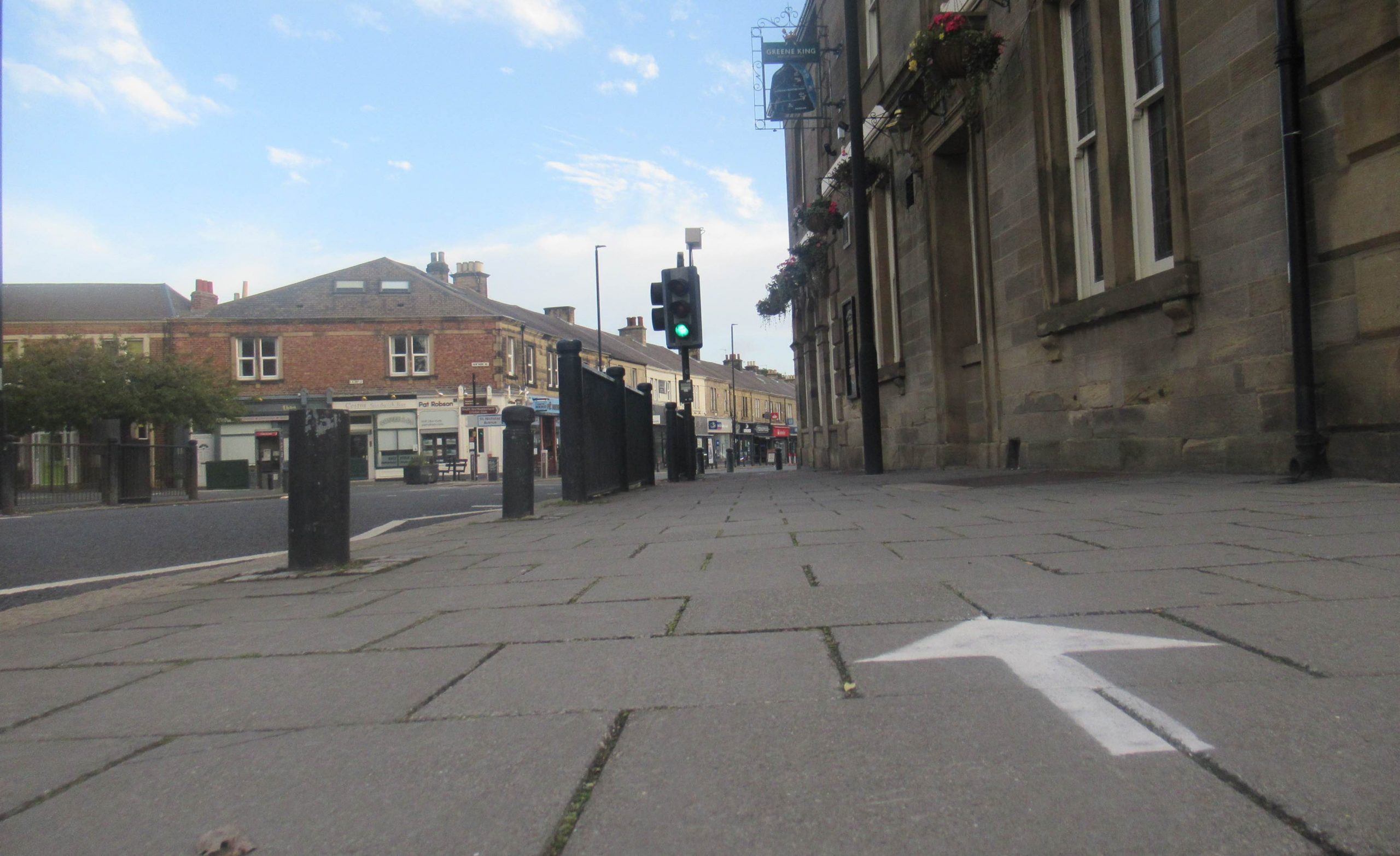
With Covid-19 cases rising again, and Government lock-down regulations further restricting how businesses operate, it is more important than ever that local streets support social distancing so that people feel safe and can confidently go out and use local shops and services. Updated government guidance (at 23/9/2020) also reconfirms the recommendation that for local journeys you should “walk or cycle if you can” to “reduce pressure on public transport and the road network.”
The Council has confirmed that its initial trial “social distancing layout” for Gosforth High Street is complete and is seeking feedback on the changes that have been made. As at the end of September, the majority of people who have provided feedback feel that the new layout is not effective in meeting the objectives to support social distancing and support walking and cycling.
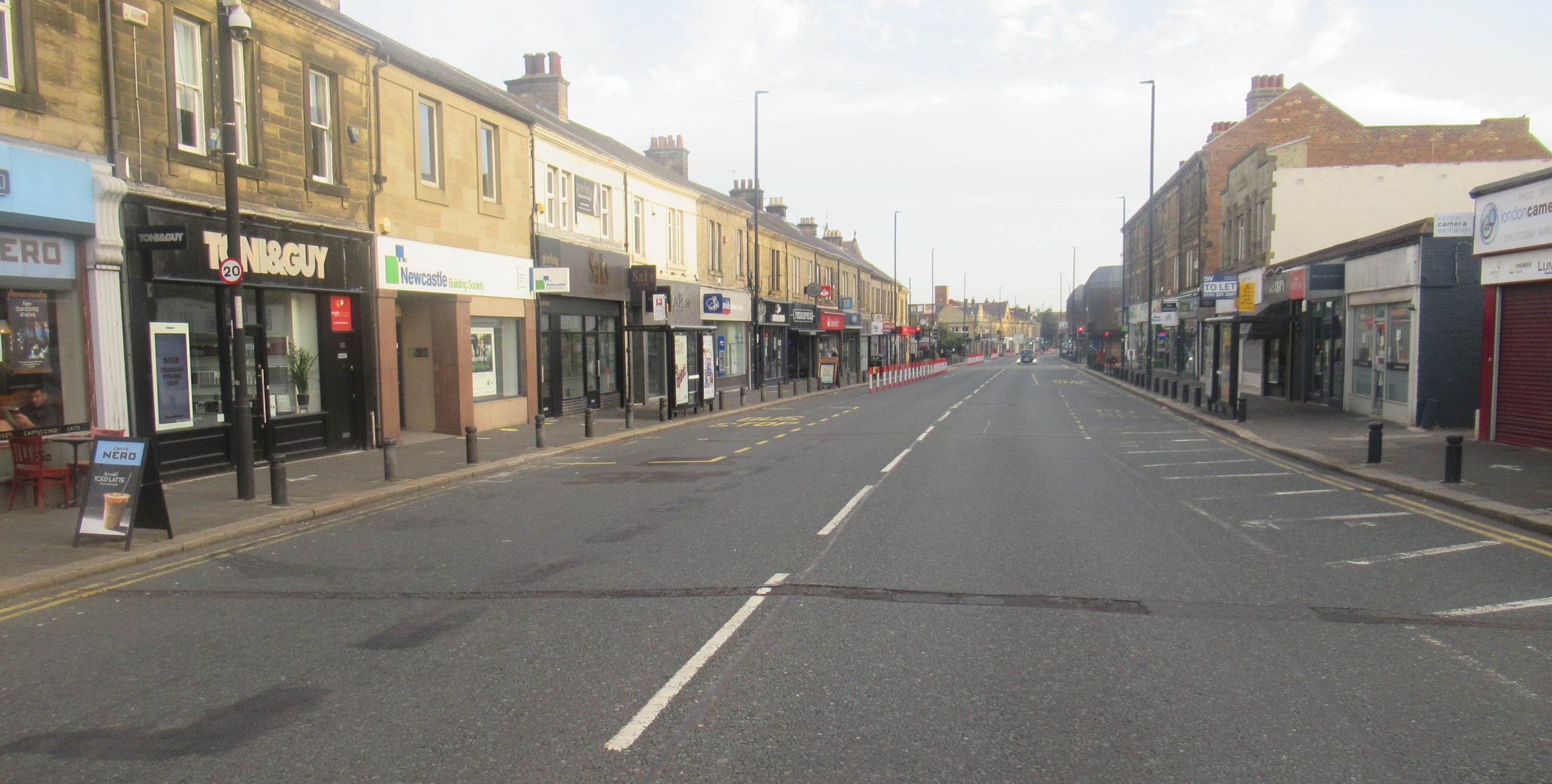
Does this layout support social distancing? Or walking and cycling?
Why have the changes been made?
The changes made to Gosforth High Street are part of the UK Government’s response to Covid-19, which has included a wide range of new regulations and recommendations about how, when and where we can travel, and who we can meet. Covid-19, as we now know, is approximately 10 times more deadly than flu, can lead to “significant ongoing health problems” and it has recently been reported that only 18% of people with COVID systems adhere to self-isolation.
The Government’s statutory guidance, issued in May 2020, stated that “Local authorities in areas with high levels of public transport use should take measures to reallocate road space to people walking and cycling, both to encourage active travel and to enable social distancing” and that those changes be implemented “as swiftly as possible.”
The government’s rationale for encouraging people to walk or cycle are:
- Because public transport capacity is reduced and if people stop cycling and drive instead then roads will be even busier than they are now.
- Because walking and cycling help improve fitness, and there is “a significant link between COVID-19 recovery and fitness”.
- Because walking and cycling are “affordable, deliver significant health benefits, have been shown to improve wellbeing, mitigate congestion [and] improve air quality.”
Gosforth has always had a high level of public transport use, both because of the Metro and the many buses that use the Great North Road, so is exactly the sort of location the Government intended to target with its guidance.
The Council say they will consider feedback after a three week review period that started on 11 September. If you have any thoughts on the scheme, including suggestions for how to make it better support physical distancing and walking and cycling, you can provide feedback at https://safegosforthhighstreet.commonplace.is
In this blog we look at aspects of the trial scheme that we think have worked, and where improvements could be made to better support the objectives set by central government.
| Provide feedback on the Gosforth High Street Plans |
Regent Centre

What has changed?
- One of the south-bound traffic lanes has been reallocated to enable the pavement on the east side next to Gosforth Central Middle School to be made wider.
- The existing cycle lanes north and south-bound have both been protected by a row of wands.
As we said above, one of the government’s objectives is to encourage active travel to reduce pressure on the road network. This photo from November 2019 shows how danger for people walking and cycling was designed-in to the existing road layout.
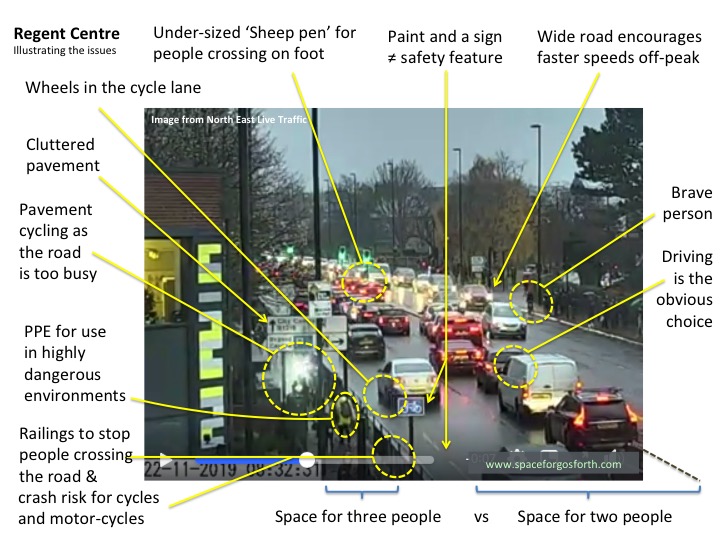
Regent Centre traffic camera – November 2019
This section of the Great North Road has always been the weakest link in the cycle route linking Brunton Lane to Little Moor via Moor Road North and Moor Road South. Adding protection to the cycle lane here addresses many of the issues in the picture above and makes this section far safer for people to cycle.
The pavement along this stretch is also narrow, and on the east side the width is further reduced by guardrail. Adding to the width of the pavement here helps social distancing, especially when the pavement is busy around school drop off and pick up times. Removing the railings would add further to the space available for people to walk.
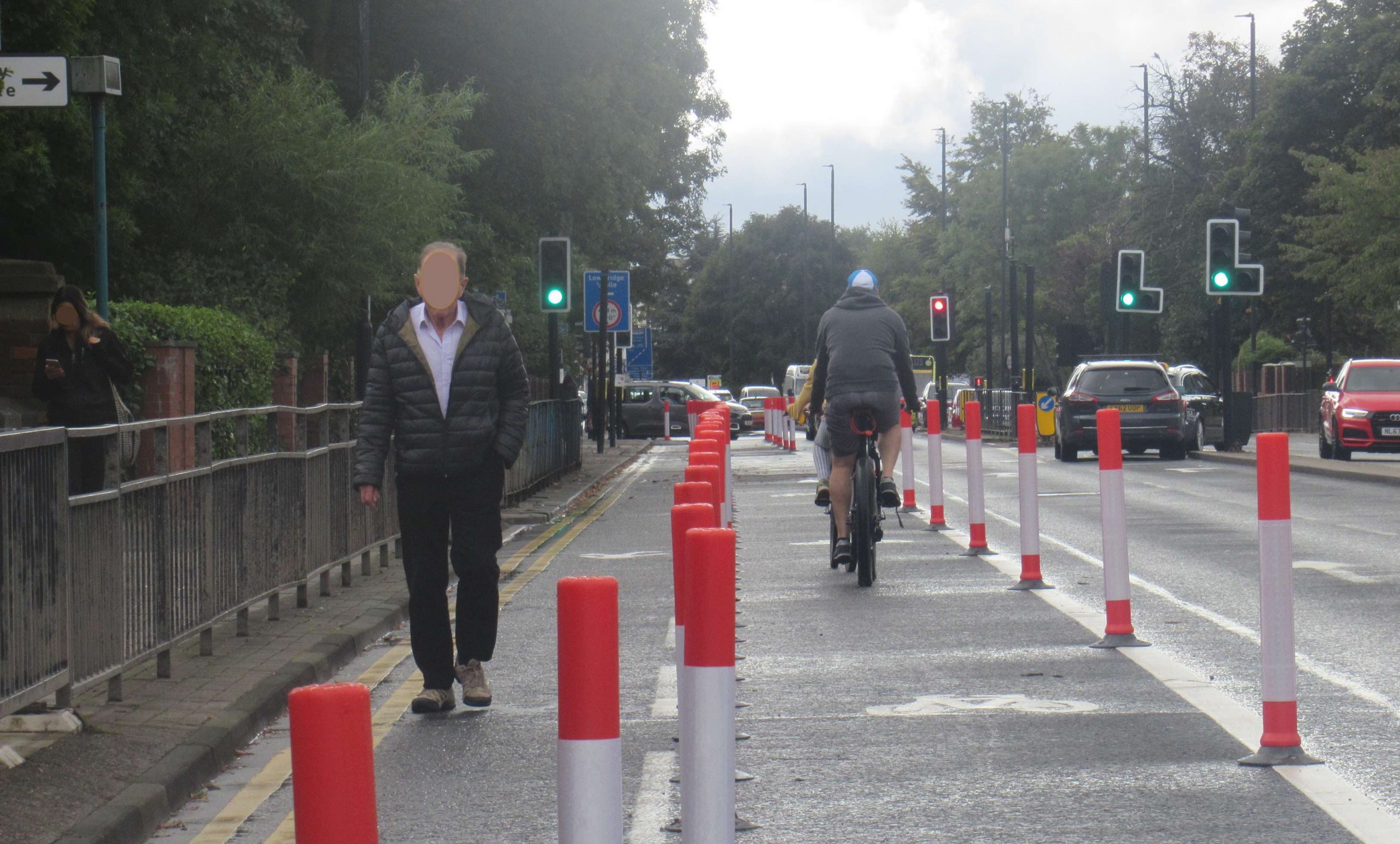
Extra space for walking and a protected cycle lane next to Regent Centre
This more recent traffic camera picture below shows how the cycle lane is now protected in both directions, and how cars heading southbound are now directed towards the middle of the road. Prior to this change it was common for cars to cut into the cycle lane where it passes next to the pedestrian crossing, creating a risk for people cycling.
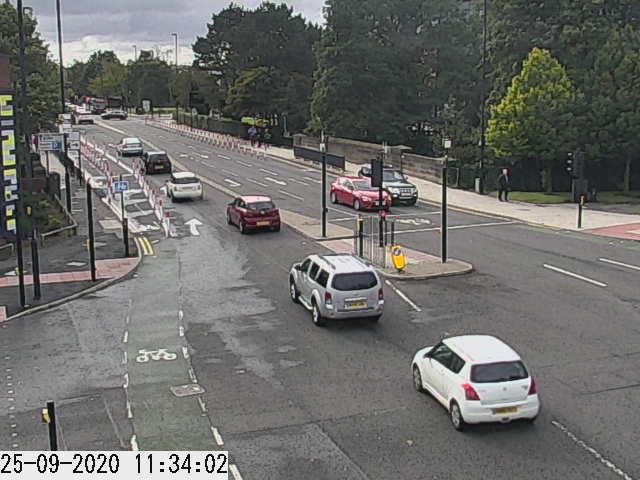
Traffic Camera view of the Metro bridge at Regent Centre
Changing this has made little difference to vehicle traffic as very few buses use this section of road and other vehicles heading south have to filter into the right hand lane after Christon Road anyway.
There are still issues though. The north-bound lane cycling lane is only partially protected and its still not unusual to find yourself in a situation like in the photo below where the cycle lane directs you into a dangerous position on the inside of an HGV.
Protecting the cycle at this point would help substantially. It would also help to remove a section of railings just north of Asda to allow access to and from Asda without having to use Hollywood Avenue.
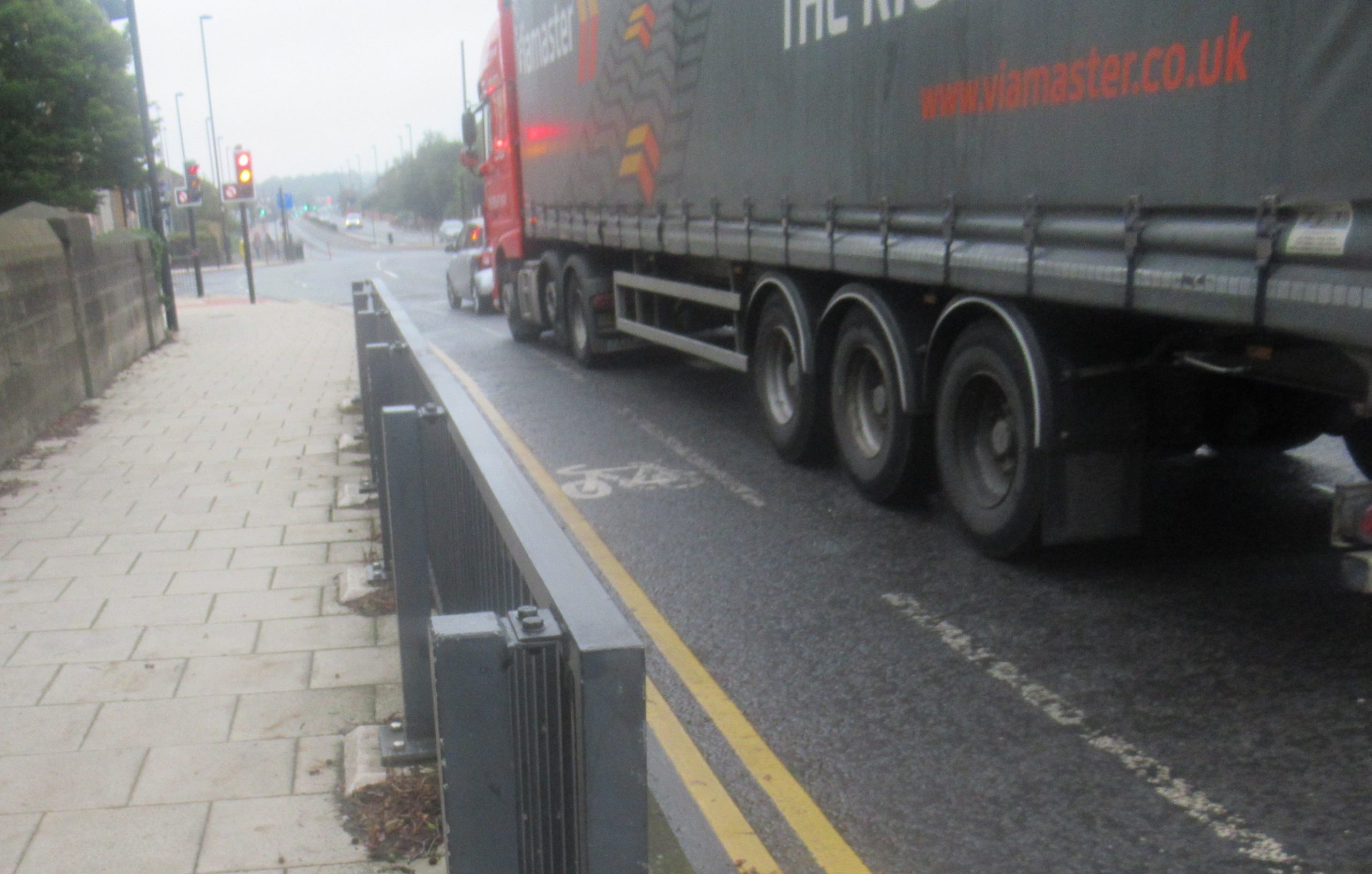
Unprotected cycle lane in the HGVs blind spot next to Regent Centre
We have also highlighted previously that the crossing by Christon Road is not large enough. If this were a single stage crossing, there would be plenty of space for both walking and cycling, and the crossing itself could be adapted by simply removing the railings giving more space for everyone to cross. This would also reduce the danger to children stuck at the edge of the crossing.
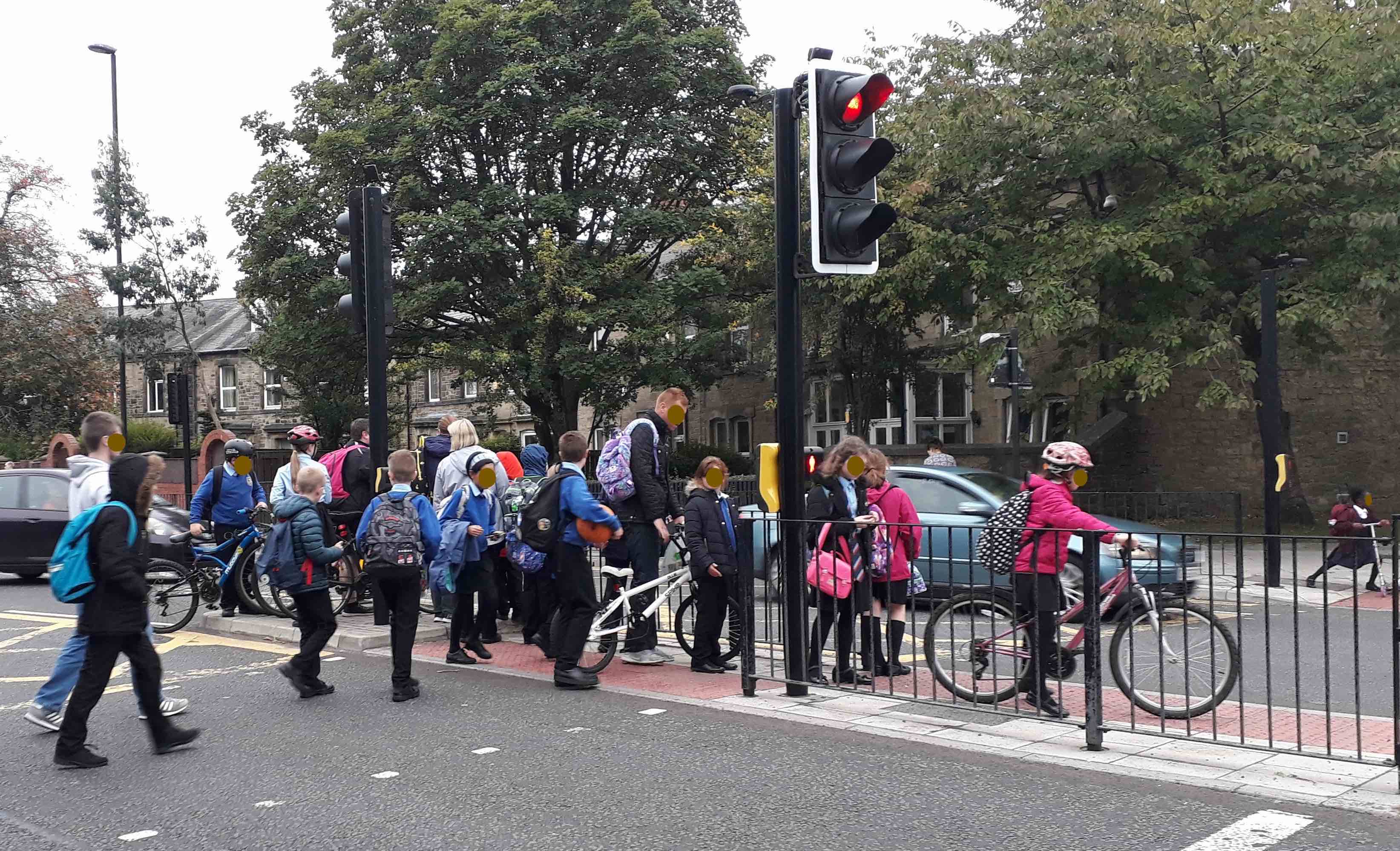
Children crossing the Great North Road by Christon Road – picture taken July 2019
Christon Road to Salters Road

What has changed?
- One of the north-bound traffic lanes has been reallocated to create a protected cycle lane.
- There is now only one traffic lane entering the Salters Road junction heading south-bound.
This is another section of road that previously most people would not have been willing to cycle but now can, at least if heading north. The lane is interrupted by the bus stop, and some people might find the speed humps uncomfortable, but both could be easily resolved if further funding is released by government. Initial government funding only covered low-cost temporary materials.
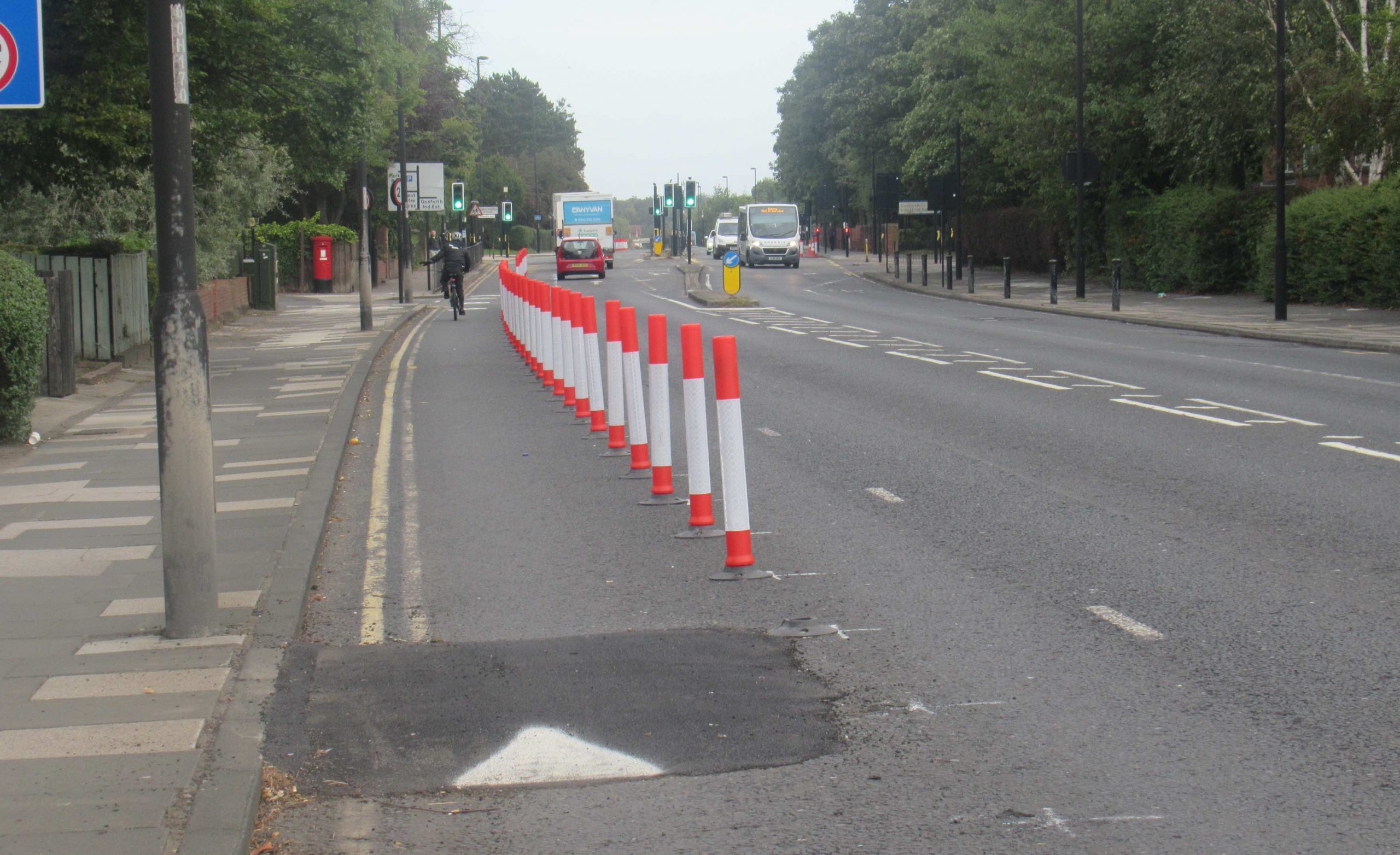
North-bound cycle lane just south of Henry Street.
South-bound, there are no additional facilities for walking or cycling, though the pavement is wide enough already. Rather than hashing out the central section of the road (as shown in the picture below), it would have been possible to create a protected cycle lane heading southbound from the end of the bus lane to connect to the advanced stop line at the traffic lights.
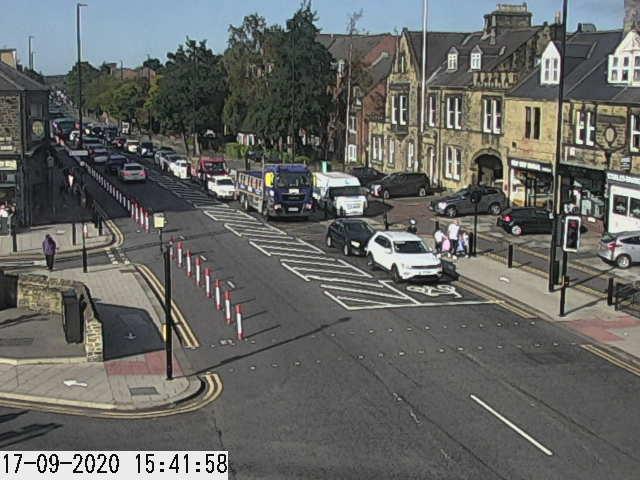
Traffic Camera looking north from Salters Road
Salters Road to St Nicholas Avenue

What has changed?
- One of the north-bound traffic lanes has been reallocated to enable the pavement on the west side of the road to be widened.
- The north-bound road layout at Salters Road junction is substantially unchanged and there is still one north-bound / left-turn lane and one right-turn lane.
- Railings have been removed by the Queen Victoria pub and replaced with a row of wands to widen the pavement.
Outside Barluga and Trinity Church wands have been used to widen the pavement. These are the same type of wands as have been used north of Salters Road for the cycle lane, but we know this is intended for walking because the give way markings at West Avenue have been moved in line with the wands. If it was for cycling, the give way lines should have remained where they were to give priority to people travelling along the main road.
An even better arrangement would be to move the give way lines to before the pavement so people walking along the main road also have priority as we proposed in 2016, or make the current road exit into permanent pavement like at Woodbine Road, effectively expanding Trinity Square across the ends of West Avenue and Ivy Road.
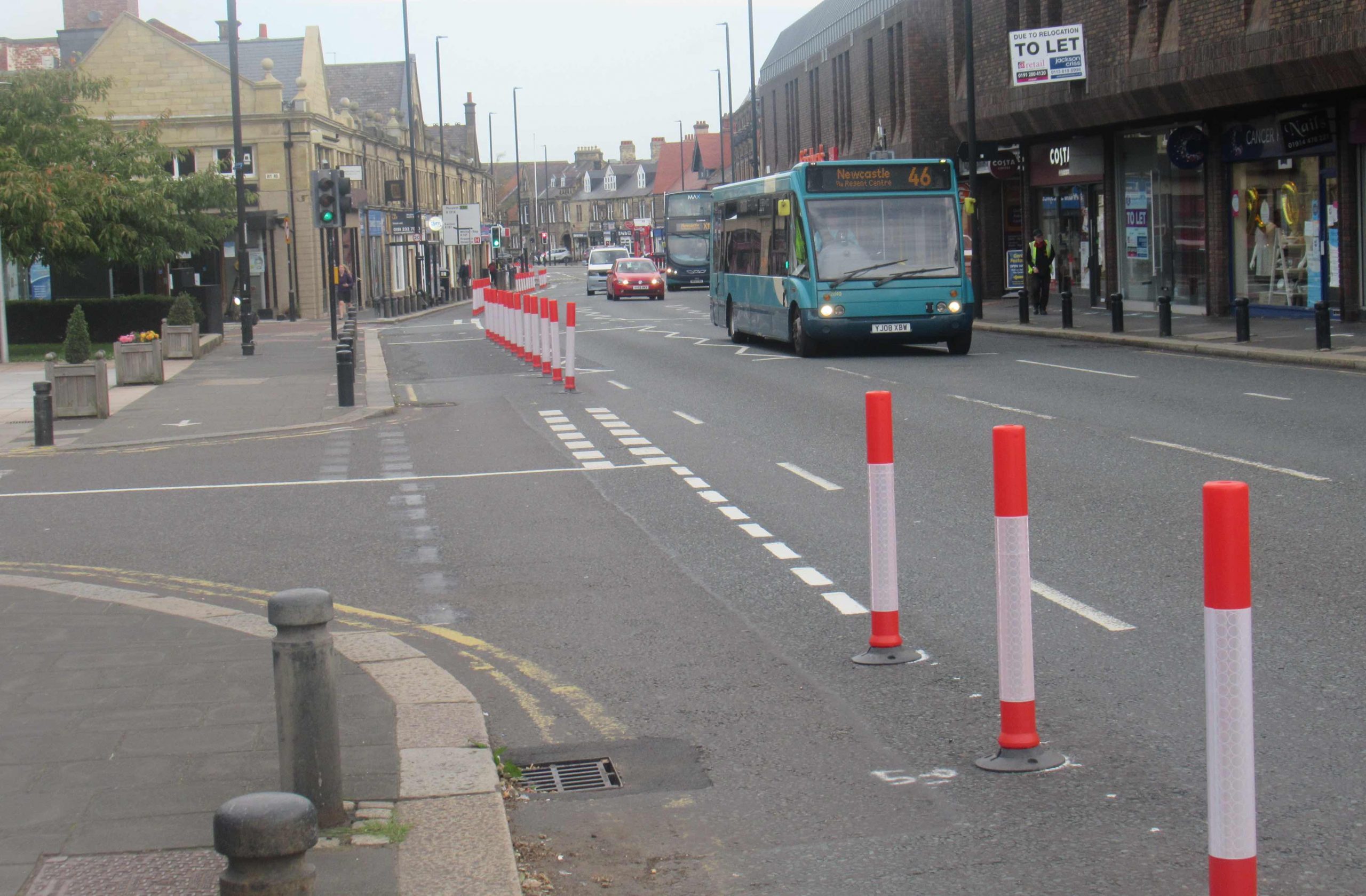
Junction of West Avenue and Gosforth High Street
There are still narrow sections of pavement on the west side, especially at the north end of the High Street. In the picture below, there’s little extra space to queue for the bus, and cafe seating (which normally would be a good thing) further reduces the pavement width to less than 2m.
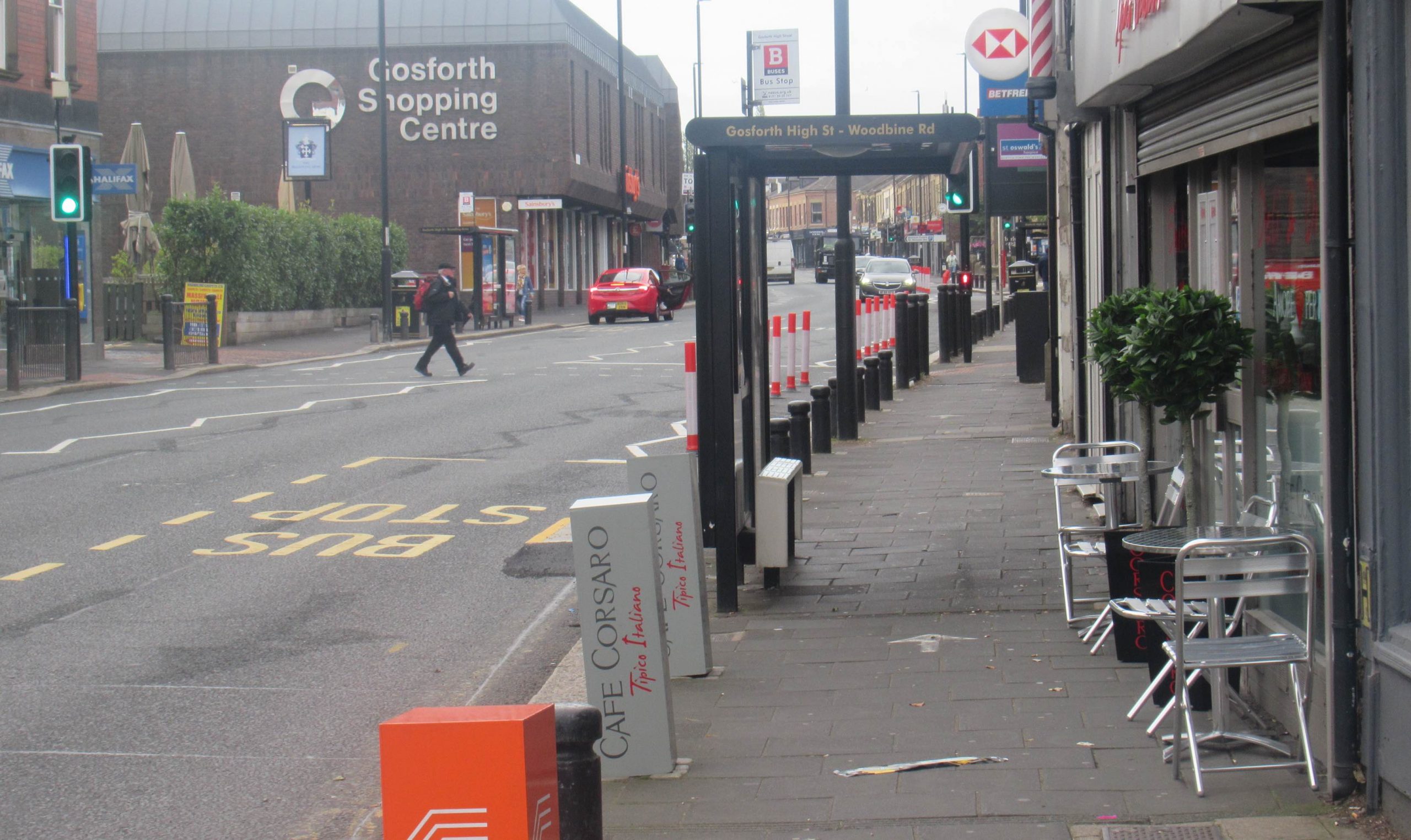
Cafe Corsaro
Next to Salters Road by the junction, the extra pavement space is not well used. If this is to be retained as pavement then the railings would need to be removed and a more substantial barrier inserted where the wands are to protect people from moving traffic. Alternatively it could be repurposed as a cycle lane to enable people cycling to access the advance stop line and the cycle lane heading north at the far side of the junction.
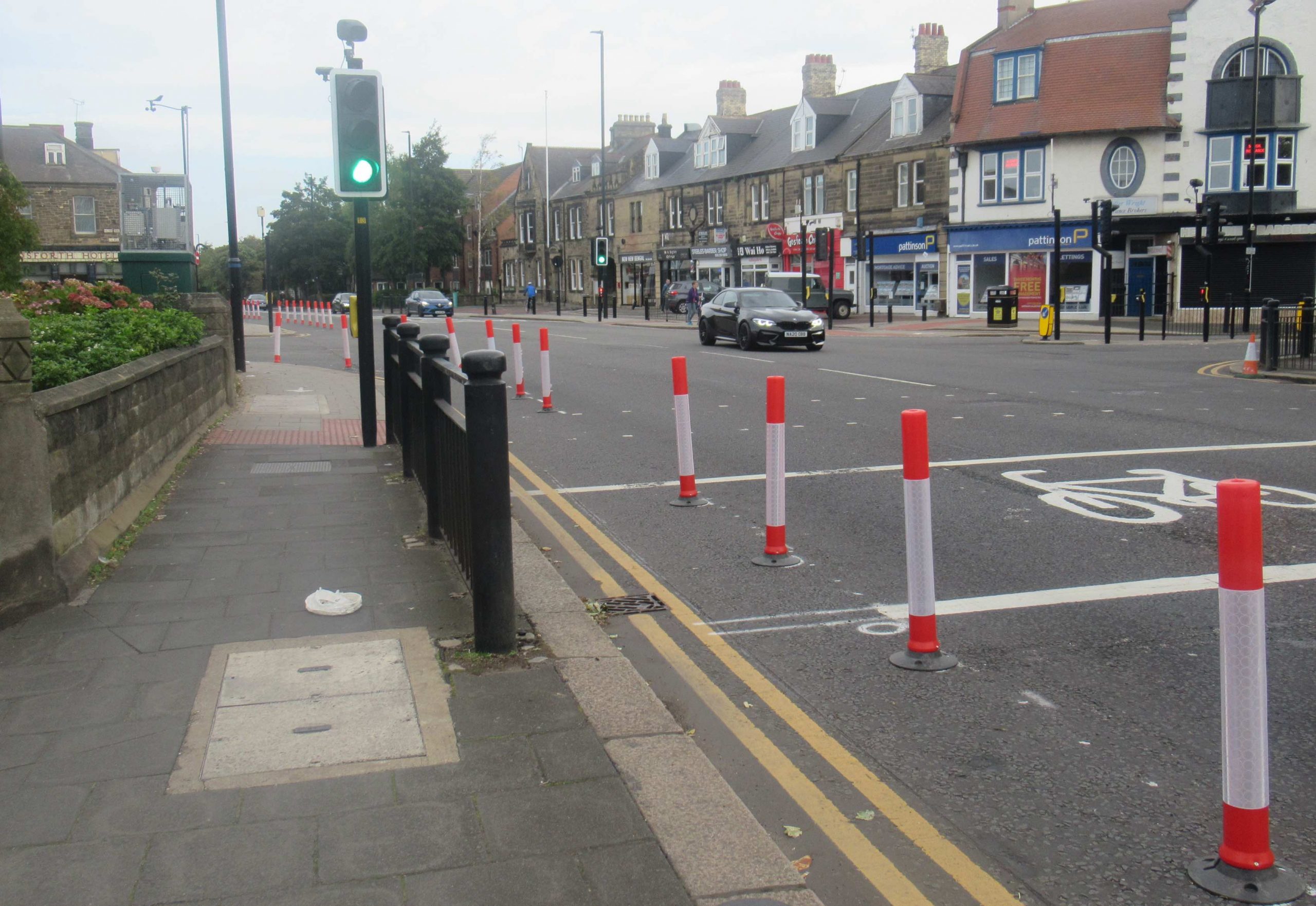
Junction of Gosforth High Street and Salters Road / Church Road
While the west side of the High Street has space for social distancing along most of its length, the east side still does not. The pavement outside Gosforth Shopping Centre is not much wider than 2m, far short of the 4m advertised in the proposal. The south-bound traffic lane next to the pavement is only lightly used, so it could easily be converted to extra pavement space.
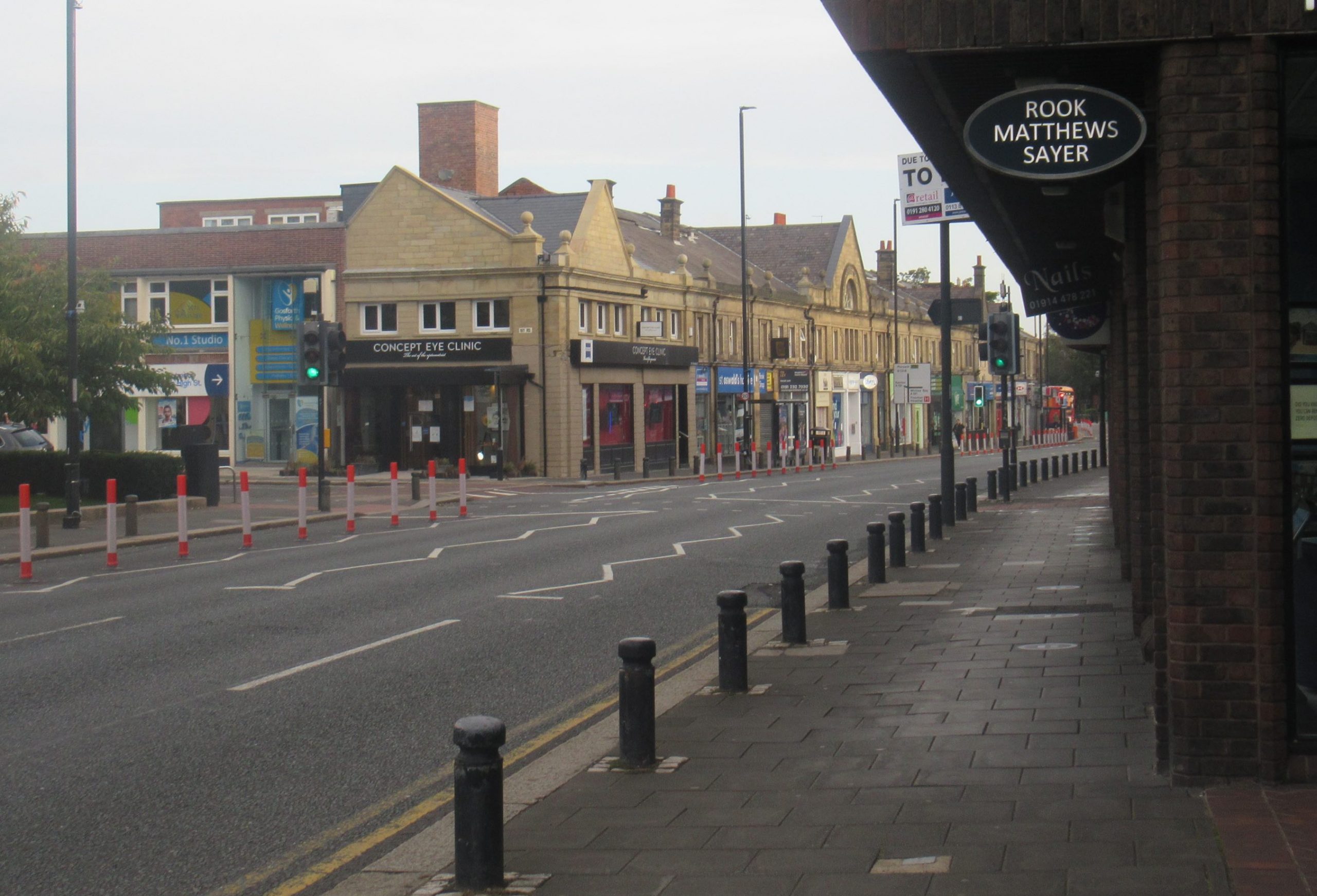
Rook Matthews Sayer, Outside Gosforth Shopping Centre
Adding to the pavement here would also create space for people to wait for the pedestrian crossing, and reduce the width of the crossing.
The one section of the pavement on the east side that has been widened is by the Queen Victoria pub, previously one of the narrowest pavements on the High Street. Here the Council have removed railings that used to cramp the pavement so now the full width of the pavement is available for use. Not being able to use the full pavement width is an issue for much of the High Street because of bollards and other street furniture.
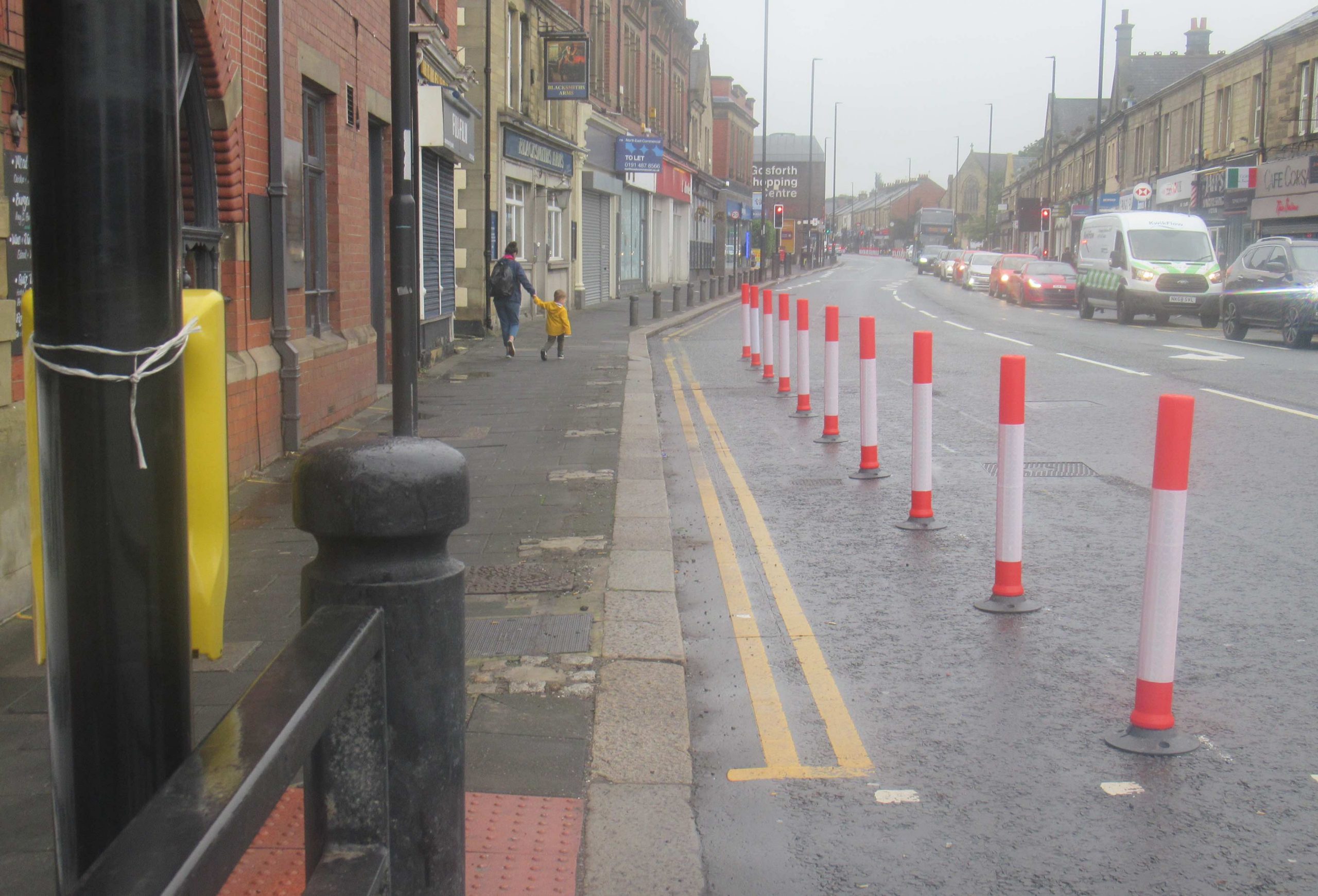
New wider pavement on the east of the High Street next to the Queen Victoria pub
St Nicholas Avenue to Hawthorn Road

What has changed?
- Part of the north-bound traffic lane has been reallocated to enable the pavement on the west side of the road to be widened.
For most of the road between St Nicholas Avenue and The County very few measures have been taken to support social distancing or enable walking or cycling. This is one of the widest sections of the High Street being over 12m for most of its length. That’s space for two 3m road lanes, two 1.5m cycle lanes with plenty of space left for a bus lay by or loading. For comparison, the road lanes outside Gosforth Shopping Centre prior to these changes were each approximately 2.5m wide.
This section of the High Street would also be the perfect place should local businesses want to try something like a car-free Saturday, as has proved a success at Park View in Whitley Bay.
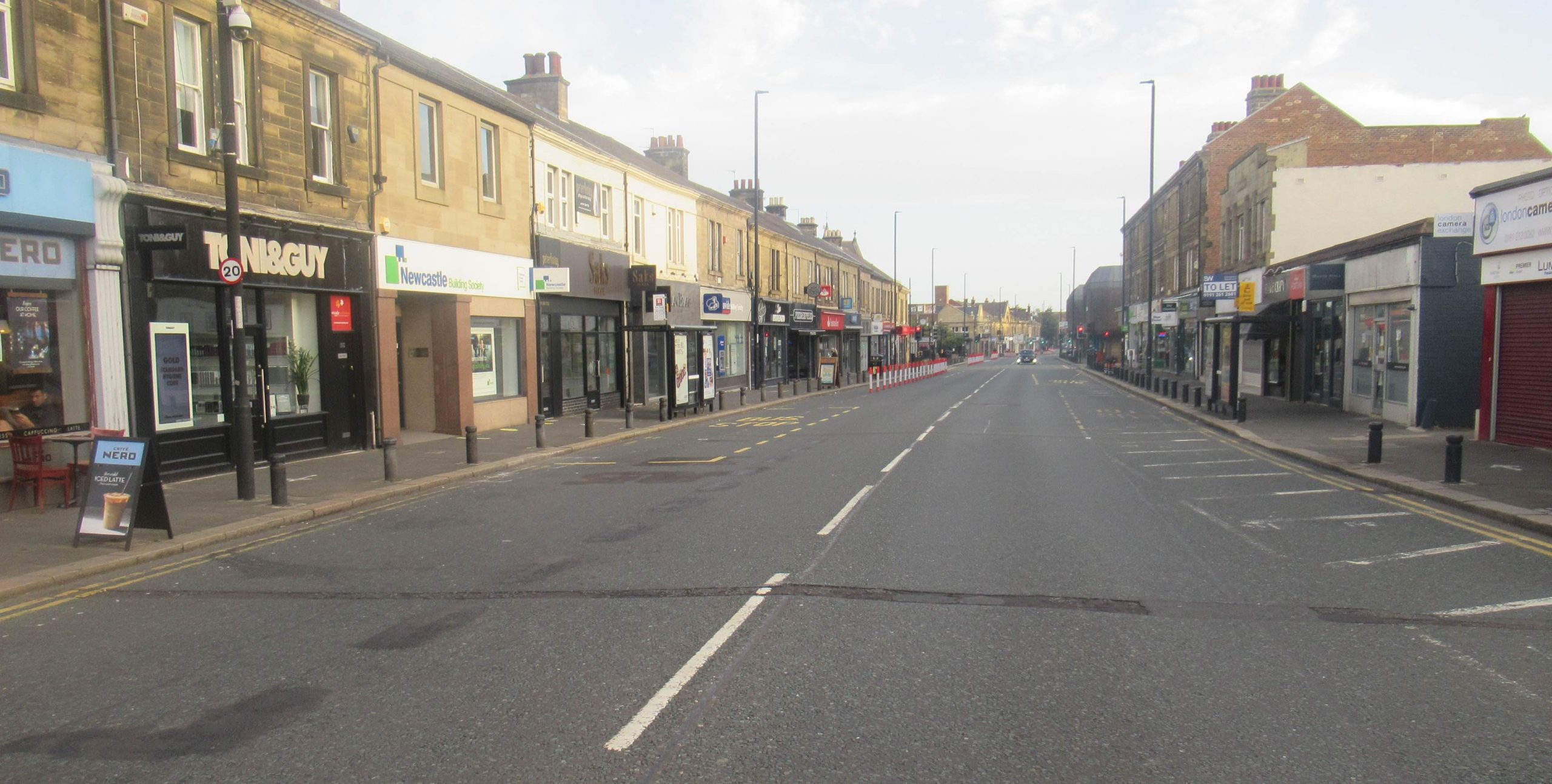
Looking north from The County pub. No measures implemented here.
By St Nicholas Avenue extra space has been marked out and, while people mostly stay on the existing pavement, people are using the extra space to overtake or enable others to pass if walking in the opposite direction. In these locations, at least, the one-way walking arrows could be removed.
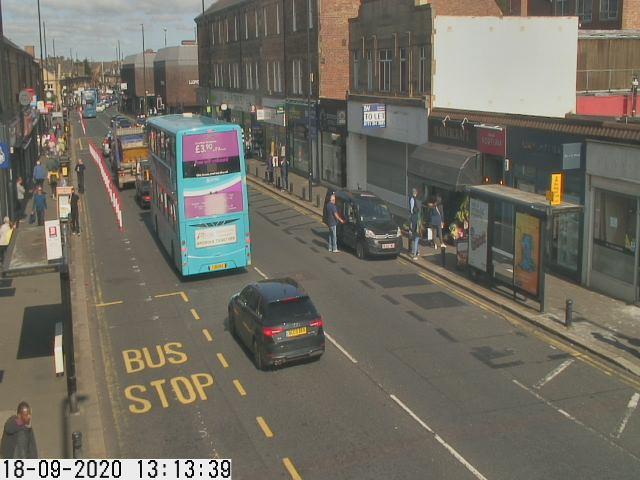
Traffic camera view showing busy pavements and a queue outside Flowercraft
South of Hawthorn Road

What has changed?
- The existing south-bound cycle lane has been protected by wands.
- A new protected cycle lane has been created north-bound, also using wands.
The south-bound lane still suffers in part from being blocked by parking, but the wands do make it safer for people cycling on this section of road.
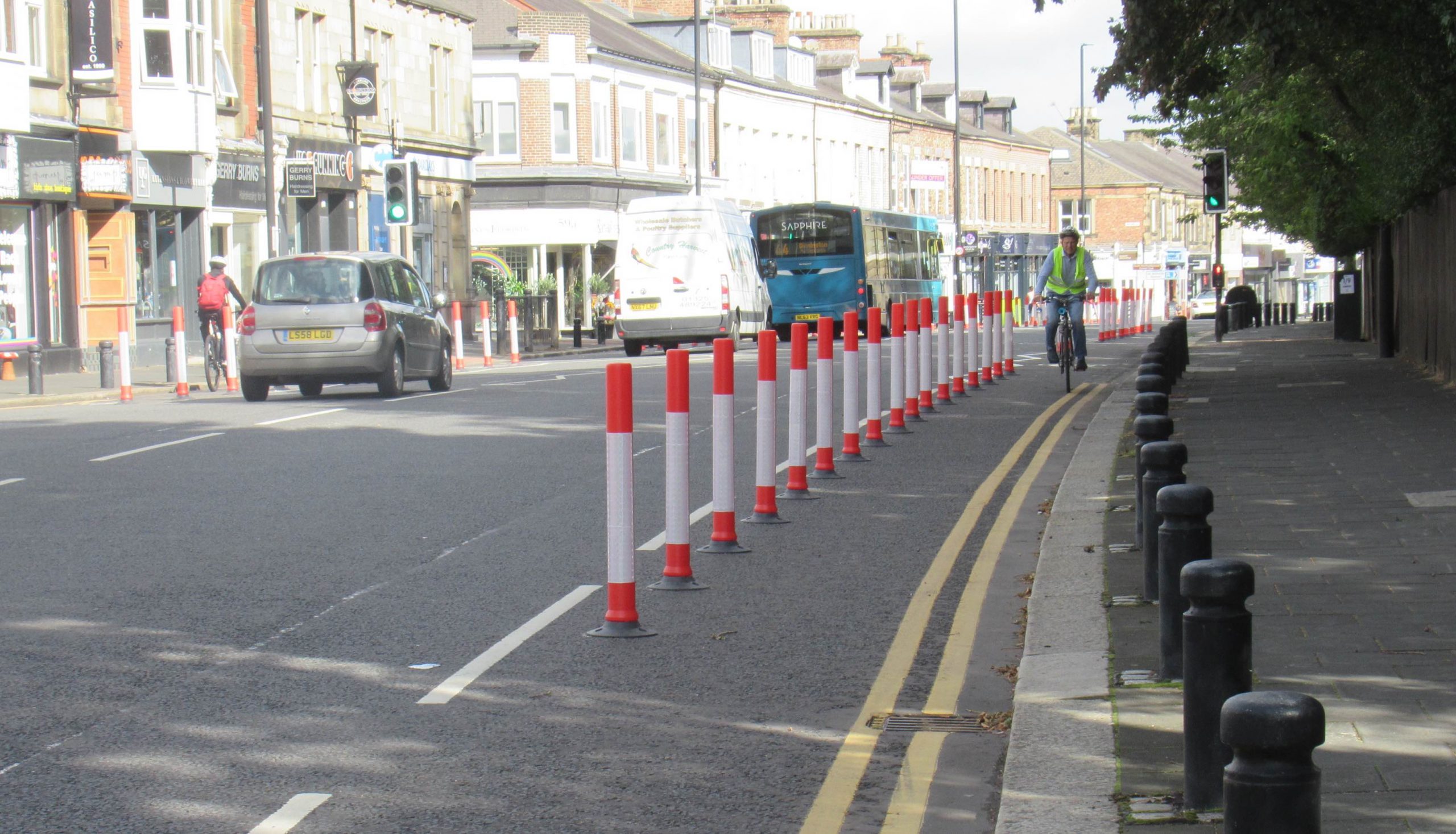
South-bound cycle lane opposite Elmfield Road
The extra north bound lane means people cycling north can continue to Hawthorn Road before turning left rather than having to turn into Elmfield Road, which is narrow and frequently uncomfortable because of high levels of traffic.
It also means people who want to social distance can step into the cycle lane briefly if they need to pass someone, without risking being hit by a car or a bus.
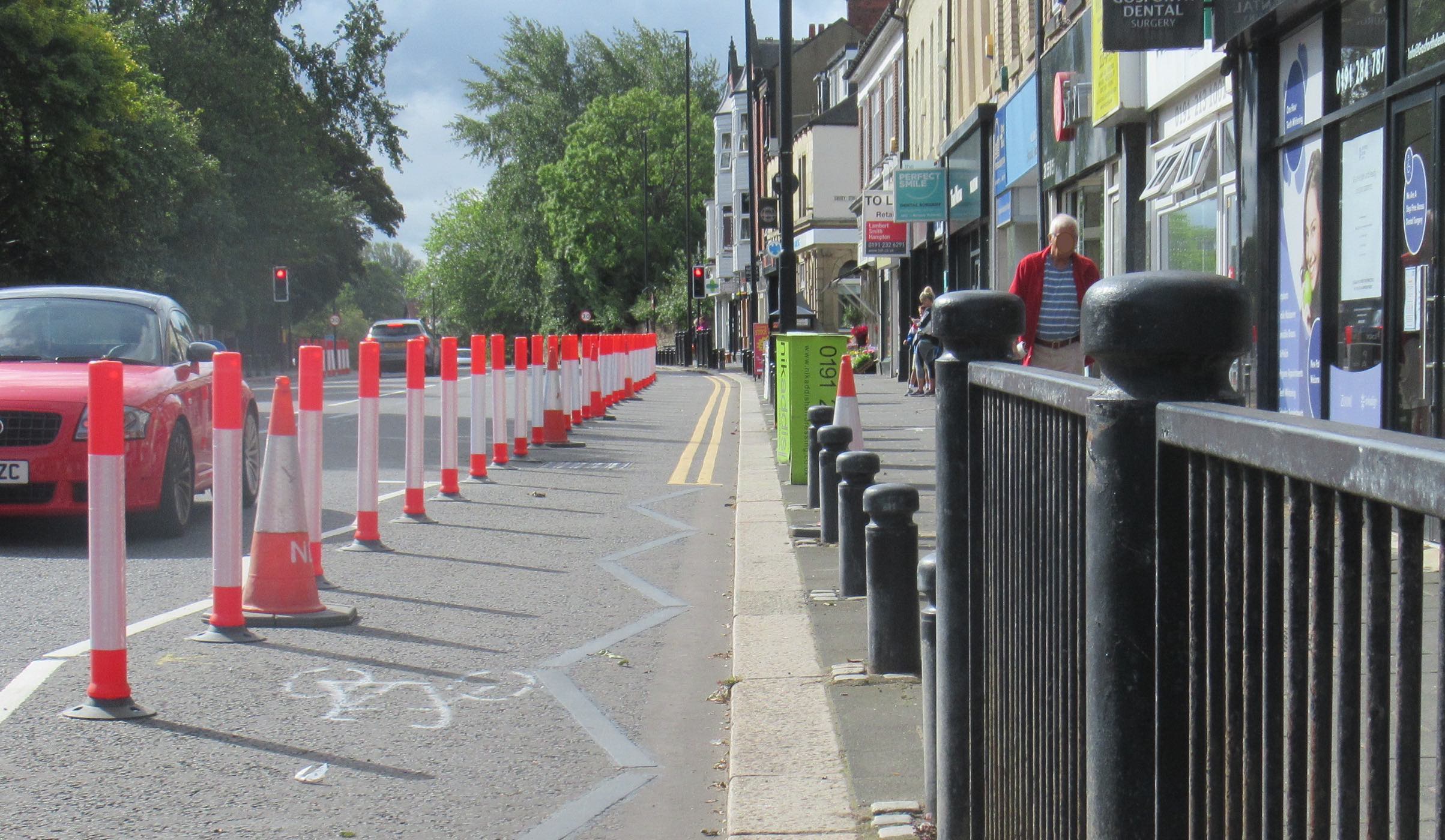
North bound cycle lane between Elmfield Road and Hawthorn Avenue.
| Provide feedback on the Gosforth High Street Plans |
Emergency Services
Despite the High Street still being very wide (approximately 9m in the picture below), we know some people have shared concerns about traffic holding up emergency services. We don’t have access to specific figures but it is a reasonable assumption that heavy traffic could have an impact. This would be the case whether this scheme had been implemented or not.
The Blue Light Aware website contains instructional videos for how to drive if an emergency vehicle needs to get past and is well worth a look. Even better – leave your car at home when you can, to avoid adding to the traffic.
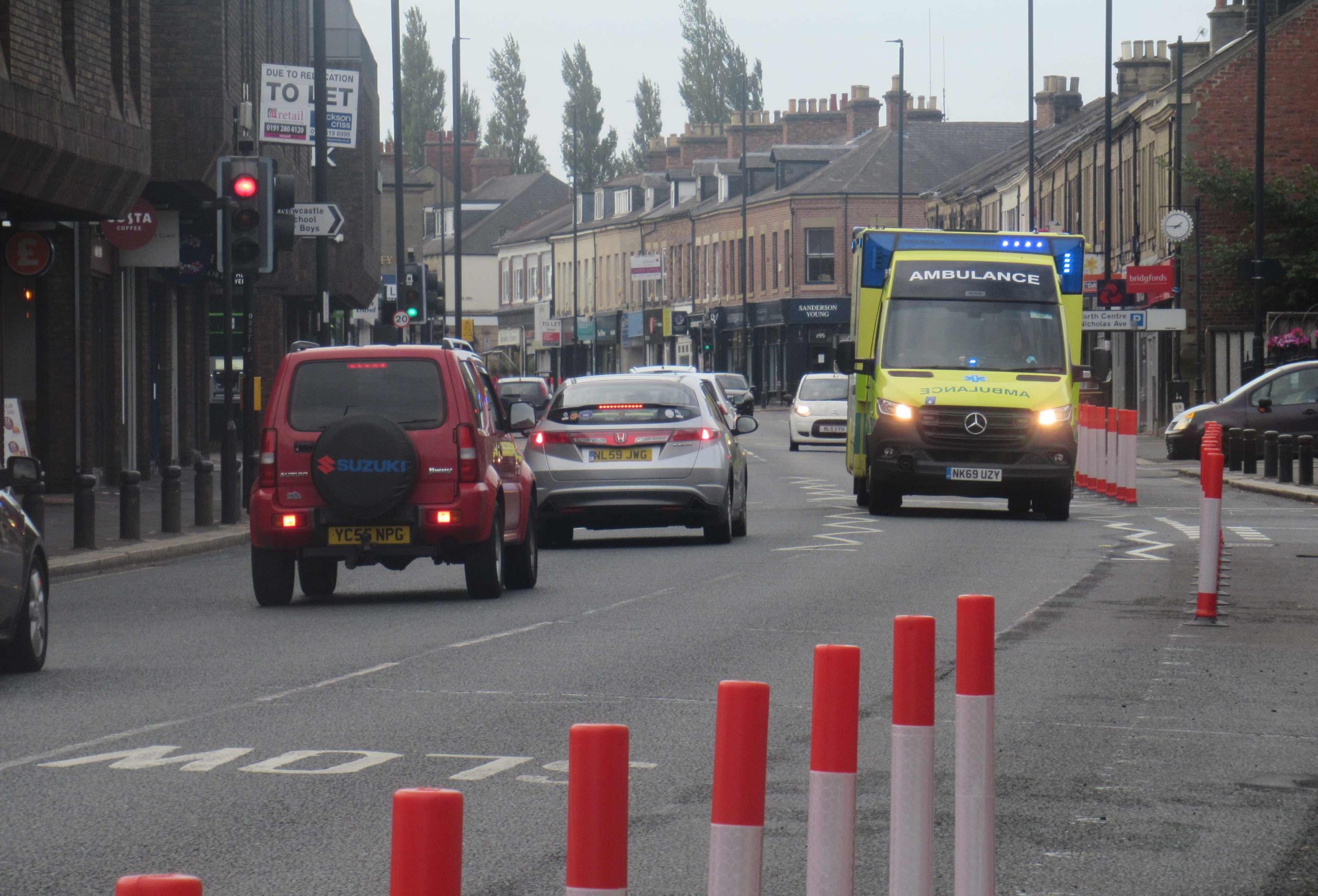
Ambulance with blue lights next to Trinity Square.
There are a number of potential options that could be considered to improve the design for emergency services, while also helping to meet the objectives of the scheme:
- Replacing wands with bolt-down kerbs that cars can drive over if needed to get out of the way.
- Better enforcement and / or updating road markings to prevent parked cars obstructing emergency vehicles.
- Creating a 2-way cycle lane that emergency services can use to bypass traffic if needed, but which can be used at other times by people cycling, scooting or mobility scooters.
- Remove the kerb separating north and south-bound traffic lanes by Regent Centre.
We do know that data from Waltham Forest where low-traffic neighbourhoods have been implemented showed no adverse impact on emergency response times.
Air Pollution
While it’s too early to draw any lasting conclusions, air pollution measurements from the Urban Observatory suggest that air quality on Gosforth High Street in September 2020 has generally been better than in previous Septembers. The map below shows the location of monitors and nitrogen dioxide (NO2) concentrations in September 2018, 2019 and 2020. Figures highlighted in red are above the annual average legal limit of 40μg/m3.
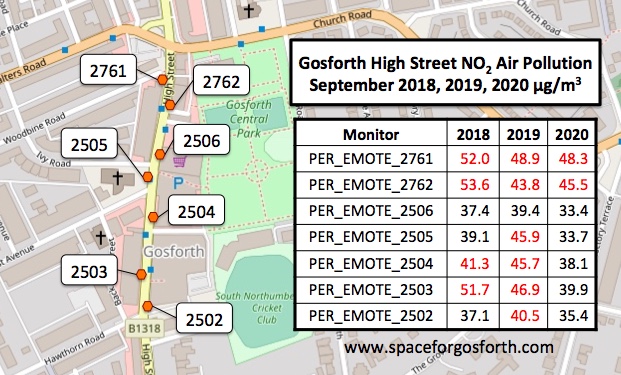
Urban Observatory Air Pollution averages for September 2018, 2019 and 2020. Higher values = more pollution.
Main Road Traffic Re-Routing via Minor Roads
A concern we highlighted in our blog Enabling Businesses to Open Safely on Gosforth High Street from July was the potential for traffic to re-route via minor roads rather than staying on the main road network. Since then UK-wide data has been released showing that in the last ten years across the UK traffic levels on minor roads has increased dramatically, believed to be largely due to the use of sat navs in cars. Google itself has published an article on this Google Maps 101: How AI helps predict traffic and determine routes.
Our experience locally is that current traffic levels are no worse than in 2019, but 2019 levels of traffic on minor roads, including on Moor Road north and south, are still unacceptable. Hollywood Avenue and the area around Stoneyhurst Road have been much improved by the installation of “point closures” to stop main road traffic using these routes as an alternative. The same approach needs to be used on minor roads either side of Gosforth High Street to make them safe as well.
Cycling Routes
For cycling more generally, we have seen suggestions that everyone should use the Moor Road North / Moor Road South route. This is a bit like suggesting cars are banned from Gosforth High Street and should use the A1 western bypass instead.
All types of transport rely on having a network or grid of routes, the only difference being the density of the grid. Walking should be possible via all streets, cycling via a grid of about 400m (the distance between parallel routes) or less near major destinations, and driving with a grid > 1km other than for access. Within those grids, some routes might be defined as being for longer journeys, like the A1, and others like Gosforth High Street for accessing local destinations.
The map below shows a possible grid of cycling routes, that also shows how Gosforth High Street currently acts as a barrier for east / west journeys. One main reason more people don’t cycle is danger from vehicle traffic. In Newcastle’s twin city of Groningen where safe routes have been provided, 61% of all trips are made by bicycle, including more than 70% for trips made to educational institutions.
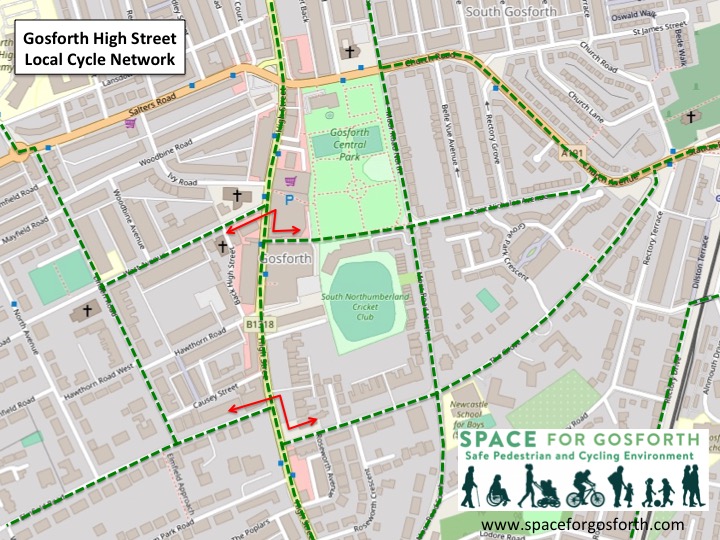
A possible grid of cycle routes to access shops and services on Gosforth High Street.
| Provide feedback on the Gosforth High Street Plans |
Next Steps
One option would be just to remove the scheme and revert back to how it was. While that might have an advantage of familiarity, it would do nothing to help achieve the government’s objectives to enable physical distancing and help people to walk or cycle. Many of the responses to the Council’s survey mention pollution and congestion, but Gosforth High Street has long been one of the most polluted, congested streets in Newcastle, and also has a poor safety record. Returning it to its original layout would not solve any of these concerns.
A High Street that is polluted, noisy and dangerous, and where social distancing is difficult, will not help local businesses. if we want a street that is less polluted, less noisy and less dangerous, that can only happen if space is made available, as the government has instructed, to allow people to walk and cycle safely. If that does impact journey times for vehicles, and we can’t be certain for a few months until changes have bedded in whether it will or not, then the Council will have to decide if it values a cleaner, safer High Street or if priority will be given to passing traffic.
If you haven’t already, please do take a few minutes to provide feedback to the Council via https://safegosforthhighstreet.commonplace.is
Update 11/12/2020
Newcastle City Council have released their report on the High Street measures, stating that “the social distancing measures on Gosforth High Street between Regents Centre and Elmfield Road should remain in place” and that “the review panel has decided that the benefits to people’s health and the local economy far outweigh the criticisms.” There is a link to the detail report at the end of the Council news story.
Some key findings from the report:
- The initial high congestion levels have settled into a pattern now that schools have returned.
- Air quality has not been degraded and as mode use continues to alter, this is likely to settle further.
- Bus operators are now finding little delay southbound.
- No issues reported by the fire and ambulance services.
Recommendations in the report:
- The northbound section from Hawthorn Terrace to Salters Road should be reserved for those on foot and marked appropriately. The use will be clarified with pedestrian symbols on the carriageway and the ends of the widened sections are to be closed.
- Communications around the purpose and operation of the scheme should be improved. The directional arrows upon pavements should be removed.
The Council feedback website is still open if you wish to provide any further feedback or suggestions for how to improve the scheme: https://safegosforthhighstreet.commonplace.is
The SPACE for Gosforth response
The following is the SPACE for Gosforth response to the Council regarding the initial temporary measures. This was sent on 4 October 2020.
I am writing on behalf of SPACE for Gosforth to respond to the Council’s Safe Gosforth High Street consultation.
I have attached a pdf copy of our detail review, which is also published here: https://www.spaceforgosforth.com/safe-gosforth-high-street/
While the scheme isn’t quite what was advertised, there are some good parts, which we have tried to highlight in the article, especially the Regent Centre changes and protecting the cycle lanes south of The County. Where the pavement has been widened, the High Street does feel more comfortable to use on foot, even if it is not as clear as it could be which parts are widened pavement and which are cycle lane.
Having reviewed the Commonplace feedback though, it looks like many of those that have fed back do not think the initial layout is effective (or sufficient?) to support social distancing or to enable more walking and cycling, while others appear to be trying to second-guess or challenge the government guidance on social distancing.
Much of the negative feedback appears to be related to the inevitable short-term disruption, which wasn’t helped by A1 works or the gas works on Jesmond Dene Road. These talk about congestion and pollution, but we have looked at pollution figures, published in the blog, which show September this year had cleaner air on average than either September 2019 or September 2018. Arguably also, a few minutes extra on a short journey is also a small inconvenience compared say to not being able to see friends or family, mandatory self-isolation for vulnerable groups or the closures of schools over the summer term.
To some extent, this is just the nature of the trial process, which we support, that you have to try something and then adapt from there. Hopefully the large amount of feedback provided will enable you to do that and the next iteration of the scheme will better enable social distancing and further improve facilities for walking and cycling.
Some additional points from us:
- Government guidance for travel (at 30/9/2020) still says walking and cycling should be the preferred modes of travel, and that we should all maintain 2 metre distance where possible to minimise risk of transmission. https://www.gov.uk/guidance/coronavirus-covid-19-safer-travel-guidance-for-passengers
- There needs to be some explainable logic linked to that guidance as to where on the High Street wider pavement is needed (or not needed) for social distancing, where a cycle lane that allows people on foot to pass is sufficient, and where the pavement can be left as is. Currently the scheme contains a mix of approaches, including some pavements that are not much wider than 2m, which we think will be adding to people’s unease.
- In some places the road width is still up to 9m wide, which encourages vehicle speeding and overtaking outside peak hours, and on multiple occasions I have seen cars racing off the line heading south from St Nicholas Av. While acknowledging the need for deliveries and emergency services to pass we think this needs to be addressed, not least so the extra space can be used in support of the scheme objectives to enable social distancing and active travel. We have included some ideas to support emergency services in our review.
- Both the Grey Street and bridges schemes have benefited from inclusion of change to improve the look and feel such as planters. It would be useful to consider this for Gosforth High Street as well. Extra cycle parking, like the rack designed to look like a parked car on Collingwood Street, could also be installed at the end of Hawthorn Road or St Nicholas Avenue.
- It would also show some joined-up thinking if the next iteration considered streets either side of the High Street and what needs to be done to allow social distancing there e.g. Regent Centre, Christon Road, and prevent main road traffic from re-routing e.g. Linden Road, Elmfield Road, Moor Road North, Moor Road South.
- It’s good to see the walk to school week comms but prior to this Council comms have been fairly infrequent whereas most guidance on situations where people are being asked to change what they do recommend frequent reinforcement of the objectives and benefits of the change. Transport for Greater Manchester have done a lot on this and I expect they may be willing for other authorities to re-use their materials? e.g. https://twitter.com/OfficialTfGM/status/1312393231456501762

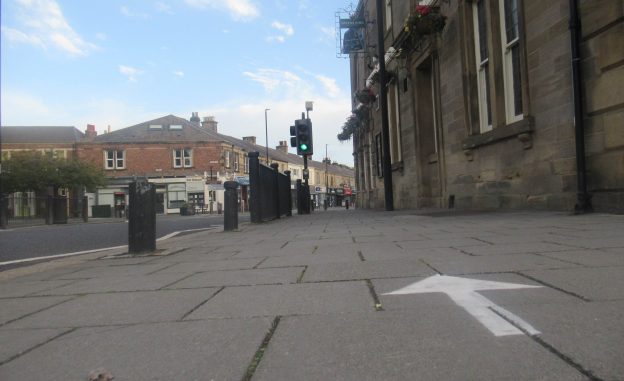
Someone ([WORDS DELETE]) has taken some considerable time to prepare this. It is heavily weighted to the view of the anti car / cycle user but maintains that a lot of these changes are required for COVID. We might have a vaccine in a few months hopefully so not sure we should redesign the entire city roads, stop businesses being viable and totally demonise car and van drivers on that basis. I note the continued suggestion of walking or cycling for every journey possible. That is not possible for a great many people who have to travel with the elderly, children, equipment, deliveries, long distances etc etc. A few main observations. According to this document very few buses travel south on the stretch between christon road and salters road. Really? so the many many buses that enter the ‘regent Centre Metro bus interchange’ travelling south at ASDA. Where do they go? Do they hop on the metro for the remainder of their southbound journey? Utter rubbish. That is making up the evidence to fit your preferred outcome. The salters road junction is so bad now that most users wanting to access streets off salters road, schools etc cut through the residential streets that are narrow with parking both sides. I have lived twice separately on Salters Road and when you buy a house on there i knew it was a main road with heavy traffic use and accepted that. I did not expect all vehicle users to suddenly desert it and clog up the other narrow residential street around it. There is a suggestion to put a footpath across the bottom of West Ave as they did many years ago with Woodbine Road. Why stop there? Let’s do it to all streets in gosforth and you can then only enter if you are not in a dreaded vehicle. Woodbine Road is entirely residential. The last time I looked there were quite a few business on West Av (School, hotel, nursery, religious venue, Restaurant, church, cafe, care facilities. How would you propose they take deliveries? by large wagons circumnavigating the residential streets for ten minutes then driving down a dead end and reversing the length of the road back up to Linden Road. Idealistic nonsense I am afraid. The back lane for the high street between West Avenue and Hawthorn Road is now the only way many cafes, restaurants and other businesses can receive a delivery. There used to be the possibility of larger delivery vehicles stopping for short periods of time on the high street but they can no longer do that again diverting these large vehicles onto residential streets.
Dear James, thank you for taking the time to read the blog.
We’ve clarified, and I think you accepted, via the SPACE for Gosforth Facebook group that the issue relating to disappearing buses was a misreading of the blog and that the section correctly referred to in the blog as only having few buses is between Hollywood Avenue and Christon Road.
I’m also happy to clarify that your suggestions to ‘demonise drivers’, ‘close all roads’ and ‘walk or cycle all journeys’ regardless of distance or ability are also completely made up.
Many of the issues you refer to are complex, but also potentially solvable. They required constructive discussion and weighing up the options and alternatives. Hyperbole and scare stories help no one, and certainly not the people you profess to be concerned about.
We do share a concern for local businesses and possibly you missed our recent advertising campaign in support of local independent shops. There’s plenty of evidence of the benefits of improving shopping centres for walking and cycling and how that helps local businesses. If you don’t want to take our word for it you are welcome to search for yourself.
You also seem to be giving a view different to that provided by the government and media on when vaccines will be available. It would be useful if you could at least support that statement with a link or similar. Most reports I have seen suggest late 2021 at the earliest. In the absence of that, the government have proposed to make it easier for people to walk or cycle. We covered the well-evidenced reasons for this at the start of the article, including a link to the government’s instruction to local authorities. Many of these resaons will continue to be relevant even once a vaccine is found so I don’t believe there is a conflict between short and long-term planning as you suggest.